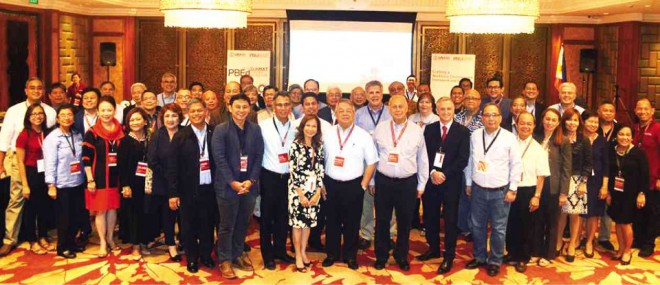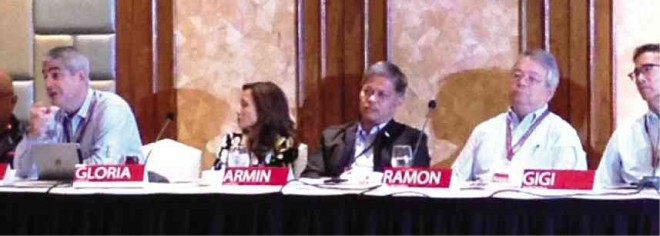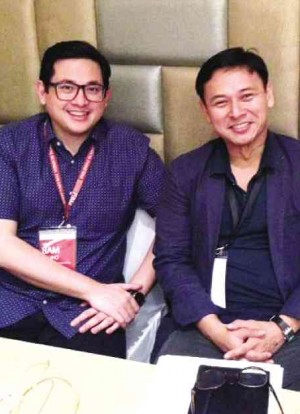Education and employment: The twain must meet

ALL-STAR CAST The CEOs, university presidents (private and public), representatives from government, media and professional organizations invited to the PBEd summit
(Part 2)
“It is a narrative that we all dream of rewriting,” said Philippine Business for Education (PBEd) chair Ramon del Rosario, referring to the paradox of heartening economic growth alongside glaring unemployment in the country.
For the top CEOs, university presidents and representatives from government, professional associations and media invited to the recent PBEd summit at Shangri-La Mactan Resort in Cebu, solving the paradox became the challenge at hand.
Unemployment was worrying, said US Agency for International Development (USAID) mission director Gloria D. Steele, because of its implications on poverty and inclusive growth. Although the Philippines achieved the highest GDP growth in the region in 2013, it also had the highest unemployment rate. Even more worrying was that the poverty rate was higher in the first semester of 2014 than the first semester of the previous year, according to Steele, who has been steering USAID support for the annual PBEd Summit for Higher Education.
This year’s summit seriously looked into involving the government in a dialogue with the education and industry sectors, not to find a stop-gap formula for creating jobs but, more substantially, to design an honest-to-goodness framework for workforce development. It was just as well that among the participants were three key representatives from government: Education Secretary Armin Luistro, Sen. Juan Edgardo “Sonny” Angara and Sen. Paolo Benigno “Bam” Aquino IV.
Article continues after this advertisementContrary to what most people think, the objective of workforce development is not just to connect jobseekers to jobs and, voila, no more unemployment. In an evolved society, students get the support they need to transition from relevant education to meaningful employment, and that’s because human capacity needs to be carefully planned and developed.
Article continues after this advertisementIn other words, while it is a concern that the youth should find work, the kind of work they find is an even more important issue. Do we want to keep sending young teachers overseas to work as domestic helpers? Do we want to see Nursing graduates queuing up for employment at BPO companies year after year?
“Where do we want to be as a nation?” Del Rosario asked.
In some ways, the previous two summits led to the workforce development agenda of the June meeting—a natural progression of things, so to speak.
The first summit in 2013 brought together a large group of top-level executives from academe and business to look for ways to reform higher education so there would be, among other things, a better match between skills and the labor market.

Jaime Augusto Zobel de Ayala, Gloria Steele, Education Secretary Armin Luistro, Ramon del Rosario and Aurelio “Gigi” Montinola III
PBEd president Chito Salazar recalled why that first summit was a milestone of sorts. “We got all three sectors of higher education to come together and agree on a vision for education.”
The three sectors meant universities and colleges that were (1) privately owned, both secular and nonsecular, (2) state funded and (3) locally funded. There were 40 of them, represented by their presidents, including the University of the Philippines, Ateneo de Manila University and De La Salle University, considered the Top 3 higher education institutions (HEIs).
By the second summit, there were more CEOs than presidents of HEIs in attendance and more than double the number that showed up the first year, perhaps because they realized that ignoring skills shortages would limit their industry’s growth and ability to adapt.
There were 40 university presidents and 15 business representatives at the first summit; 14 university presidents and 33 CEOs joined the following year.
“We started talking about technical-vocational education, on-the-job training (OJT), and recognizing prior learning,” Salazar recalled.
It became clear that closing the skills gap was not just a higher education issue but also concerned technical-vocational schools. This was because more and more jobs would be requiring more than a high school diploma but less than a four-year degree.
Among the offshoots of the earlier summits, according to PBEd executive director Love Basillote, is a career exploration portal to disseminate information to and from both the supply and demand sides. Since career planning should ideally start in high school, PBEd pushed for the creation of FutureYou.ph, an online site where secondary students can check out the profiles of 230 schools, including their performance record in licensure examinations over the past five years. FutureYou.ph also offers more than 50 job profiles from nine industries, based on what the Department of Labor and Employment and the Department of Trade and Industry consider the “hot jobs” in the near future.
As likewise recommended by the previous summits, PBEd has partnered with the Commission on Higher Education to undertake an industry review of the curricula for four specific courses: Business Administration, Information Technology, Hotel and Restaurant Management, and Electronics Engineering. Industry associations assisted by identifying the competencies they needed.
“Over 800,000 students have gone through these curricula,” Basillote said.
Another result is the National Industry-Academe Council, which is made up of 10 CEOs, eight school presidents and two representatives from the government. Oriented toward employability, the council also created an OJT consortium “to make sure the OJT system is relevant for all three stakeholders, meaning the student, the school and the company,” Basillote said. A manual and a code of conduct for all parties concerned are due to come out soon.
After the retrospective on the first two summits, Steve McGill of Pearson Markets Asia gave a presentation on global trends, issues and best practices in workforce development, providing context and takeoff point for the afternoon sessions where the participants gave concrete recommendations that would align the youth, the schools and the businesses toward a productive labor market and a healthy economy.
Four themes—labor market intelligence, sectoral councils, apprenticeship and education governance—guided the discussions that were later presented in the plenary session for consensus. The themes deserve a separate write-up in future Learning issues.
From academe-industry linkage to a multisectoral approach, from bridging skills gaps in individual industries to advocating for workforce development for a nation in desperate need of it, the PBEd Higher Education Summit has found its bearing and right purpose.
